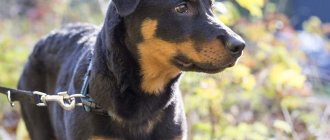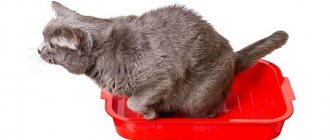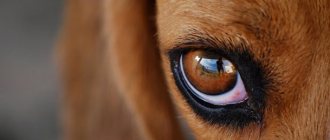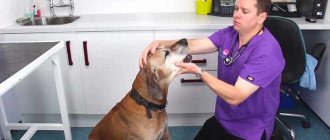Eye diseases are a common cause and dog owners often seek help from doctors. Modern veterinary clinics have veterinary ophthalmologists who can help treat a dog’s eyesore. Dog breeders bring their pets to see a doctor and report the presence of a cataract, but few people understand what it is and what it looks like. It is for this reason that we will describe this disease and what symptoms it is accompanied by.
Types of disease and photos
A cataract is a scar formation. A type of pathology is scar spots, which differ in density and size:
- The spot is clear, transparent, small.
- The cloud is translucent and blurry.
- A cataract is a dense thick spot of gray or milky hue.
This pathology is dangerous for a dog; due to sprouted blood vessels, the cornea is subject to deformation. Vision disappears completely or partially.
In addition to scar formations, there are other types of pathologies. Among them are:
- Corneal ulcer – can be superficial, deep, or descemetocele. A through lesion of the eye occurs.
- Keratitis is an inflammatory process in the cornea.
- Degeneration – deposition of calcium salts, cholesterol.
- Endothelial dystrophy is a disease unique to old dogs.
- Endothelial edema - the pupil becomes blue. This happens after vaccination.
- Cataract – the lens begins to become cloudy.
- Glaucoma - at the initial stage the eyeball becomes enlarged, and then clouding is observed.
Attention! The deeper the lesion, the less pain. If a pet squints and then stops, this does not mean that everything has passed.
What it is
A cataract is also called leukoma. This is cloudiness in the eye caused by mechanical damage or infection. The cornea recovers after the lesion, but is overgrown with a white film. It also worsens the dog’s vision.
Leukoma appears as a milky white film covering an area of a dog's cornea. An aggressive inflammatory process can cause the cataract to continue to grow. So the scar can become higher than the cornea and even begin to fuse with the iris of the eye.
Connective tissue scars can be divided into 3 types.
- Central - appears in the middle of the cornea of the eye and is completely covered with a film. The dog becomes almost completely blind and can only distinguish between light rays.
- Peripheral - a cataract occurs at the edges of the cornea. The process of inflammation stopped in time preserves the pet’s vision. However, the dog loses peripheral vision.
- Total - the film covers the entire eye of the dog, which leads to complete blindness.
For what reasons can this formation appear?
Dogs' eyes become cloudy for a number of reasons:
- congenital pathology (extremely rare);
- due to injury;
- inflammatory process;
- consequence after an illness;
- the result of improper treatment of purulent inflammation.
Spots and clouds appear most often due to improper home treatment. A cataract is a consequence of purulent inflammation. There are also medications that contain lead, silver and zinc - after their use, small stains appear and they cannot be treated.
Attention! It cannot be ruled out that some breeds are predisposed to cloudy eyes. These include pugs, Pekingese, Labradors, and bulldogs.
Contacting a veterinarian
Often, dog owners seek qualified veterinary help too late, when the animal has already begun to lose its vision..
You must respond immediately if the following signs appear:
the animal's eyes become cloudy;- a white spot appeared on the eyeball;
- the dog is bothered by liquid or purulent discharge near the lower eyelid;
- There was an injury to the organs of vision - chemical or mechanical.
If the owner notices that the dog’s vision is deteriorating for some reason, especially at a young age, this is an alarming symptom that requires diagnosis.
Only in a veterinary clinic after a thorough examination and all research will an accurate diagnosis be made. Self-medication in this situation is not worthwhile.
Symptoms and diagnosis of the disease
In addition to clouding of the pupils, the disease is accompanied by a number of other symptoms. When constantly caring for your dog, they are easy to notice:
- Watery or mucous discharge appears.
- The pet behaves restlessly, is constantly afraid of something, practically does not go outside, and during walks he walks reluctantly.
- The dog tries not to be in the sun, in a room with bright lighting, and spends most of his time in a dark place.
- The cornea becomes cloudy and the eye becomes rough.
- The disease is accompanied by pain and each animal demonstrates this differently.
Treatment of a cataract in a pet begins with a preliminary diagnosis. The veterinarian evaluates the dog’s external condition and asks the owner questions. To make the treatment process faster and more effective, it is recommended to provide information:
- diet;
- frequency of walks;
- contact with other animals;
- date of appearance of the first signs of the disease;
- diseases that the pet suffered from.
After the examination, the veterinarian prescribes treatment.
Attention! If you have self-medicated at home, do not hide this information from your doctor. Often, improper treatment is the main cause of cloudy eyes.
Briefly about the main thing
- A cataract (leukoma) is a scar formation on the cornea, manifested by clouding of the eye. It is easy to confuse leukoma with other pathologies due to its similar external manifestation.
- There are several causes of the disease - injuries, other diseases and improper treatment.
- Diagnostics can only be carried out in a specially equipped clinic.
- Treatment should be prescribed by a specialist. At home, it is safe to use only tetracycline ointment and chloramphenicol eye drops.
- Prevention involves monitoring the pet’s condition and periodically caring for its eyes.
Treatment method for cataracts in dogs
Treatment is determined solely by the veterinarian. Self-medicating is not the best option because it can worsen your pet's condition. The treatment method directly depends on the cause and stage of the disease. Depending on this, a treatment method is prescribed. In some cases, folk remedies are used.
Drug treatment
You can treat a dog’s eyesore with medical medications at the initial stage of the disease. Medicines are also used to restore the health of an animal after surgery.
The following medications are used for home treatment:
- A solution of boric acid is used to remove pus and secretions. They wash their eyes.
- If catarrhal lesions appear, you will need to apply ointments or a solution of chloramphenicol. Novocaine is often injected into the conjunctival sacs.
- Ointments cope well with the problem: “Kornogel”, “Tetracycline”.
- Eye drops: “Hydrocortisone”, “Oftan”, “Lidaza”. They are administered several times a day.
- Injections. Such drugs are resorted to when vascular keratitis appears.
- Furacilin is actively used for washing; the drug helps reduce inflammation after injuries.
You need to take care of your pet's eyes regularly.
Therapeutic methods
When the first signs of the disease appear, you must immediately begin treatment for your dog. But there are cases when conservative treatment methods do not allow the dog to be cured of pathology. For this reason, veterinarians resort to surgery and remove the resulting film. If the case is severe and advanced, then the affected cornea is completely removed, after which an artificial one is inserted.
Advice! After the operation, it is recommended to use a special collar to prevent the dog from damaging the stitches and causing harm to itself.
Folk remedies
If you start treatment when the first symptoms appear, then traditional methods will help. The most successful recipes:
- Onion gruel. 2 tsp. grated onions pour 200 ml of hot cow's milk. Leave for 8–9 hours. Place 1-2 drops in each eye 2 times a day.
- Fir resin. 1 drop every 24 hours.
- A mixture of celandine and propolis. They do this: celandine juice is mixed with a solution of propolis (1%) in proportions of 1 to 3. 2 drops in each eye every other day for a week.
- Chamomile decoction. Suitable for washing.
- Boiled honey. Add 1 tsp to 200 ml of water. honey, put on low heat for 5 minutes. The solution is used for washing.
- Powdered sugar. Blow into the eyes several times a day. The powder is first sifted, which allows you to remove large particles. Subsequently, lacrimation begins, which is quite normal.
Most folk remedies allow the film to dissolve. However, it is worth understanding that improper use causes a burn to the cornea.
Features of care
There are no special care difficulties. The most important thing that the owner must remember is to prevent injury to the eye from paws; for this, the dog is wearing a protective collar.
It is necessary to follow all the doctor’s instructions and carry out the prescribed procedures in a timely manner. If the cataract can be treated with medication, the pet is kept at home.
Disease prevention
You need to know how to cure an animal's eyesore. But also be able to figure out how to prevent the occurrence of diseases. To do this, you will need to perform certain preventative measures:
- Constantly monitor the condition of your pet. Examine your eyes frequently. If you notice a white spot, you should contact your veterinarian.
- Carry out vaccinations on schedule, which will prevent possible disease.
- Strictly follow the recommendations for caring for the dog, create appropriate conditions, provide a balanced diet, and frequent walks.
- For preventative purposes, visit a veterinarian. Thanks to this approach, the doctor will be able to promptly recognize the signs of any disease and take all measures to eliminate it immediately.
Any pathologies are treated without delay. If you take a responsible approach to caring for your pet, you can avoid many problems and not endanger the animal’s health.
Signs
Visually, the thorn, which has occupied more than 20-30% of the eye, can be seen; diagnosis is not difficult.
What the owner can see:
- Cloudy spot on the eye (may appear or disappear).
- Watery eyes, discharge of pus.
- Photophobia.
During a visual examination in the clinic, a veterinary ophthalmologist notes unevenness of the cornea, the appearance of a yellowish film, which is easily removed, but then forms again.
If there is no treatment, the last stage of leukoma is characterized by thinning of the eye membrane, the thorn begins to protrude greatly.
Glaucoma
Increased intraocular pressure leads to an imbalance between the production and outflow of moisture. There are primary and secondary glaucoma. Primary can be congenital or acquired. Secondary - is the result of inflammation of the anterior chamber of the eye.
Photo
Symptoms
The main signs of this pathology include:
- Increased tear production.
- Redness of the whites.
- Swelling, “bulging” of the eye - it seems to have become larger.
- Apathy, lethargy.
- Decreased corneal brightness.
- The dog constantly whines when the area near the eye is touched.
- Loss of appetite.
- Reluctance to establish contact with other animals and people.
- Sometimes the pet seems to be lost in space.
- The desire to constantly be in the dark.
There are enough reasons for the development of the disease:
- Displacement of the lens;
- Inflammation of any part of the eye;
- Neoplasm in the eye;
- Accumulated blood after injury or surgery;
- Genetic predisposition;
- Keratitis or conjunctivitis if not treated.
How to treat: the best drugs
As in all cases of deciding on treatment methods, the decisive question is the timing of contacting a specialist.
In the early stages of glaucoma, drug treatment with drugs . The process is long and, at best, can stabilize intracranial pressure. A cure cannot be expected - the disease affects all components of the eye. Medications will slow down the process of clouding of the eye, but it will not be possible to restore vision or even stop the development of the disease.
Beta blockers, osmotic diuretics, miotics and inhibitors are used as therapeutic drugs; they will be prescribed by a veterinarian.
- To urgently reduce intraocular pressure (during an attack), a drug from a series of osmotic diuretics, “ Mannitol ,” is recommended. Application allows you to retain water for about 4 hours.
- What drops are needed to treat glaucoma? The external use of carbonic anhydrase inhibitors is aimed at reducing moisture production and, as a result, reducing blood pressure. Systemic drugs Dorzolamide and Brinzolamide have no side effects and are recommended for daily use.
At a late stage of the disease, the doctor’s task is to avoid complete loss of vision and reduce the pain that the dog experiences when IOP increases. When the disease is advanced, the only correct solution is surgical removal of the entire visual organ.
The results of glaucoma treatment in animals are incomparably lower than in humans . Surgeries to increase the outflow of aqueous humor (they are associated with the implantation of drainage tubes into the eye) or, conversely, to reduce the production of moisture (partial destruction of the ciliary body with a laser) quite often do not give the expected effect. In the end, when choosing between the painful inevitable loss of vision for a pet and removal, the doctor chooses the second. A prosthesis is implanted for cosmetic purposes.
Prevention
In order to prevent such a serious disease with irreversible consequences, dog owners are advised to monitor the condition of their pet’s eyes, promptly and completely cure conjunctivitis and keratitis, and conduct regular examinations with a veterinarian.
Cataract
This eye disease is associated with aging of the lens, a violation of its transparency - subnuclear (nuclear) sclerosis.
The development of cataracts is most likely at the age of 8 years, when the elasticity of the lens decreases, it hardens and ceases to adjust vision to different distances. It is more common in Golden Retrievers, Poodles, Yorkshire Terriers and Boston Terriers. The disease progresses over the years.
Cataract photo:
Causes
Less commonly, the causes of cataracts are heredity. Acquired cataracts occur after trauma, after inflammatory diseases, diabetes, etc.
Symptoms, treatment and diagnosis
An external sign of cataract is clouding of the lens. The cloudiness of cataracts is uneven. It is possible to recognize cataracts on your own. When a beam of light hits the affected eye, the clouding will shrink in size. In low light, on the contrary, it increases.
In some cases, this dangerous disease can develop for a long time without visible symptoms. But a dog owner may notice decreased vision by analyzing the dog's behavior.
The most reliable way to diagnose an eye disease called cataracts remains to be examined by a specialist.
Treatment without surgery
How to treat cataracts without surgical intervention at home? But no way. The use of medicinal drugs does not allow us to hope for the recovery of our four-legged pet. At best, the progression of the disease will slow down. It is possible to use drugs only at the very beginning of the development of cataracts, when surgery is not yet required. Vitamins and enzymes are usually prescribed.
Cataracts cannot currently be prevented. Do not fall for the tricks of deceivers who recommend Smirnova eye drops, vitaiodurol, vicein, catachrome, vitafacol for the treatment of cataracts . These drugs cannot prevent, slow down, or even cure clouding due to the fact that the nature of the disease is not clear.
When is cataract surgery necessary?
The only effective way to treat cataracts is surgery to replace the clouded lens with an artificial one. From a technical point of view, this operation is very complex. Its result largely depends on the stage at which the application was made to an ophthalmologist. Obviously, earlier treatment guarantees a better result.
The modern technology of lens removal using ultrasound - phacoemulsification - is finding more and more fans. But it is also effective in the early stages.
Prevention
The need for surgery is determined by the animal’s ability to navigate in space using vision. If decreased vision does not allow the dog to move without the threat of harm to health, we can talk about the need for urgent surgical treatment.
- When purchasing a puppy, you should ask whether any of the parents have been diagnosed with cataracts.
- After 6 years, it is necessary to regularly visit a veterinarian.
- Maintain eye hygiene for your pet: wipe and apply eye drops if indicated.
- A nutritious diet and adherence to the vaccination schedule are also important.
Predisposition
In breeds
According to veterinarians, some dog breeds have a genetic predisposition to leukoma, for example:
- French Bulldog;
- boxer;
- toy terrier (usually in old age);
- lapdog (Russian color, Maltese or Maltese, Havanese, etc.);
- chow-chow;
- Golden retriever;
- Shar Pei;
- basset hound;
- Saint Bernard;
- Cocker Spaniel.
Other
Also at risk are dogs that are unattended by their owner most of the time (for example, while walking), where they can come into contact with sick animals or even get into a fight (with subsequent eye injury). But older individuals are most susceptible to the disease.











